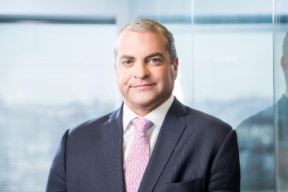Technology and innovation continue to disrupt industries and businesses around the world, and the investment management industry is no exception. Regulation – in the form of MiFID II – now adds a new challenge to an industry already wrestling with technological change in both equity trading and research. In a conversation with Traders Magazine, Tourmaline Partners CEO Aaron Hantman and Managing Partner Tim O’Halloran discuss how these trends are impacting their business.

Aaron Hantman, Tourmaline Partners
This is not an easy time to be a broker. Passive management’s impact on your core client base, technological change and new regulatory compliance requirements are just three of the challenges. Yet Tourmaline Partners grew last year. How is that?
Aaron Hantman: While we are a registered broker-dealer, Tourmaline Partners is structured and operates much differently than what most people think of as a broker. Our major differentiator is that, for all intents and purposes, we function as a “buy-side” trading desk. Given our size – last year we traded over $120B in notional value — we are covered by an extensive global network of 350+ brokers, allowing our clients to benefit from a breadth of relationships that many would almost certainly not have the scale to obtain on their own. We face off with the sell-side on our clients’ behalf and we use an expansive execution and analytics tool set to access superior liquidity and pricing. We deliver an un-conflicted trading experience, which means that we do not cross blocks of stock or shop order flow, ever. In doing so, we provide institutional clients with a global high-touch trading solution aimed at helping them define, measure and achieve best execution in listed equities and options globally. We’ve built our business not only on skill and expertise, but on client service as well.
Many people associate Tourmaline Partners with ‘outsourced trading’, which can mean different things to different people. How do you define it?
AH: When we first launched our business in 2011, we were primarily working with emerging managers who would leverage Tourmaline at the outset to handle their trading in lieu of adding staff. This was typically driven by both a need to keep costs down in a new business and also to allow portfolio managers the freedom to focus on investing.
Today, the majority of our growth comes from established investment managers, many well up the AUM scale, for whom we are providing “supplemental” support to in-house trading teams, complementing what they do on their own. Market forces are driving the need for this service and hence, our growth.
As such, we think the term “outsourced trading”, which to many implies ceding control of a process, is a bit of a misnomer. Our typical client engages us to enhance and augment their own capabilities, not hand over or replace the function. We’ve seen this in the research space for many years. It’s only natural that it is now happening with trading.
What trends can you point to that have led to Tourmaline’s growth with larger, more established managers?
Tim O’Halloran: There are a number of factors at play here. MiFID II has fueled unbundling, a trend that has been underway for some time with the institutionalization of CSAs and CCAs. Europe is fully unbundled and we now see many investment managers in the U.S. on the same path. This has led many buy-side firms to rethink how and with whom they trade, driven by best execution and a need for greater transparency. It has also led many managers to reduce their counterparty list. Managers no longer trade with a broker solely as a means to compensate them for their research.
So the typical investment manager is using fewer brokers?
TO’H: That’s what we’re seeing in our business and industry data corroborates this. It makes sense that as research and trading are decoupled, both businesses will be evaluated independently and in a more granular fashion. When a manager has fewer counterparties, this means less coverage of the market. This is where Tourmaline adds value – helping buy-side traders to expand their reach, information flow and access to liquidity.
AH: We are covered by sell-side brokers who in many cases do not cover our clients. This allows us to fill gaps and add value to our clients – particularly when executing small- and mid-cap names where liquidity may be trading away or by accessing foreign markets during non-U.S. hours. We do this by leveraging a combination of both low touch and high touch sell-side resources. Most of our traders have deep buy-side experience, know the process well and have engaged the sell-side for many years.
And this has led to both an increase in business as well an expansion of your global trading footprint?
TO’H: Yes. We are a global firm, with offices in Connecticut, London and now Sydney, which we opened last year in response to the growing desire of our U.S. and European clients to trade the Asia-Pacific markets. We now trade 24 hours a day, six days a week. We are excited to have boots on the ground in Asia, and to expand our local presence. We believe that providing quality execution is still a service business – it requires expertise, experience and a proactive mindset.
How was last year?
AH: 2017 was a good year for Tourmaline. We scaled revenue and expanded the team as we have begun to work with a broader mix of clients who vary in size and structure, from emerging hedge funds and family offices with $50M AUM to RIAs and long-only firms who are managing over $100 billion. Importantly, as our business scales, we continue to become more relevant to the sell-side and thus more valuable to our clients. We are a unique resource at a time when rationalizing costs matters a great deal to investment managers. The broader industry changes that we’re seeing certainly play a role in why Tourmaline is resonating with the buy side.
And what about research – the other side of the bundle? Does Tourmaline provide research to its clients?
AH: No, we don’t produce any research internally. As we work in collaboration with the sell-side, we’ve been mindful to not expand into their core businesses – notably, research, banking and advertising block liquidity. We exclusively provide a buy-side trading experience. By staying within this channel, we have earned the trust of the brokers with whom we interact daily. This is important to our clients. We do, however, allow clients to fund CSA and CCA accounts with Tourmaline. This has been a core initiative to ensure that anyone trading with us has the ability to fund their research budget.
TO’H: This was also driven by client demand. In the past year we have built a robust commission management and trade reporting infrastructure. We have also included commission aggregation, allowing our clients to fund their Tourmaline CSA when trading with other sell-side brokers of their choice. This is a natural complement to our core execution business and our ability to earmark or ”attribute” credit to the sell-side for research purposes. Providing flexibility to fund research budgets and centralizing the process creates greater operational leverage for our clients.
Where does Tourmaline Partners see the industry headed?
TO’H: We think that the changes we’re now seeing are still early on the curve. There is definitely more to come. It has become clear that most brokers do not want to be all things to all people. Many will pick their spots and focus on core businesses and select clients. Also – nothing happens in a vacuum. Large managers in Europe are now choosing to pay for research out of their P&L and have stated that they will therefore be spending less on sell-side research. Less money spent on research means that less research will be produced.
Meanwhile, the U.S. is watching, as are global asset owners, regulators and other stakeholders. This will open the door to a much broader conversation. In an unbundled world, all industry players will rethink many long-held practices around both execution and research. We believe that this will present some interesting opportunities for Tourmaline.
AH: We’ve already seen a number of mergers and restructurings on the sell side. Clearly research is becoming both more fragmented and “data-centric”. And to your point, passive management and other broader market forces will cause both brokers and managers to more carefully examine the economics of their respective businesses. We expect to see more of the buy side leaning on experts for a number of operational and investment functions. It is certainly happening with trading.
Lastly, we’ll need to be mindful of the regulatory nuances and client preferences in different markets. What works in the U.S. may or may not apply in Europe or Asia. Having the flexibility to manage this for our clients will be paramount.
Has Tourmaline disrupted the traditional model for equity trading?
AH: I’m not sure we would go that far. I would say that we have positioned ourselves well for the changes that regulation and technology are bringing to our industry. Hopefully, we can continue to monitor and adapt to what comes next.






